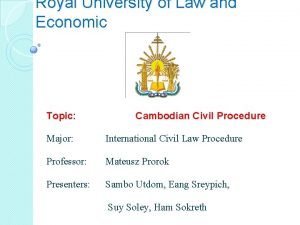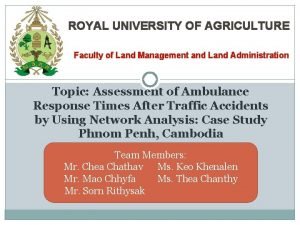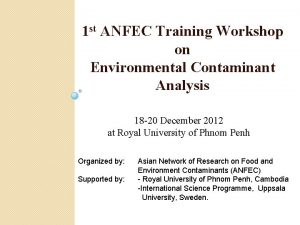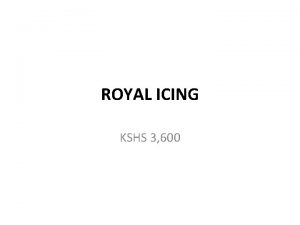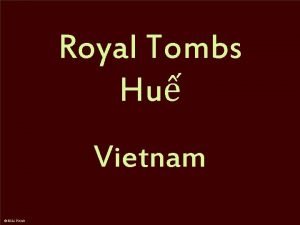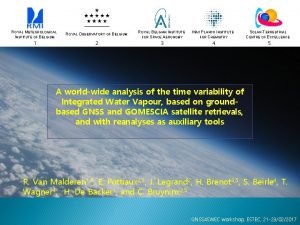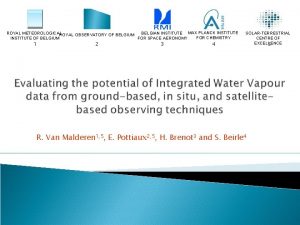1 st ANFEC Training workshop Royal University of












- Slides: 12

1 st ANFEC Training workshop Royal University of Phnom Penh On Environmental Contaminant Analysis 18 -20 December, 2012 at Royal University of Phnom Penh Organized by: Asian Network of Research on Food and Environment Contaminants (ANFEC) Supported by: Royal University of Phnom Penh, Cambodia International Science Programme, Uppsala University, Sweden.

Analysis of Arsenic By Silver Diethyldithiocarbamate Method Dr. Mohammad Arifur Rahman Department of Chemistry University of Dhaka-1000 Bangladesh rmarif@univdhaka. edu

Arsenic determination by the silver diethyldithiocarbamate method and the elimination of metal ion interferences: By Shingara S. Sandhu Reprints from the collection of the university of Michigan Library

A rapid colorimetric method for measuring arsenic concentrations in groundwater R. K. Dhara, b, c, ∗, Y. Zhenga, b, c, J. Rubenstonec, A. van Geenc a School of Earth and Environmental Sciences, NSB D-216, Queens College, City University of New. York, 65 -30 Kissena Building, Flushing, NY 11367, USA b Graduate School and University Center, City University of New. York, NY, USA c Lamont-Doherty Earth Observatory of Columbia University, Palisades, NY 10964, USA Received 5 May 2004; received in revised form 16 September 2004; accepted 16 September 2004

Spectrometric Method of Analysis Arsine (As. H 3) generation followed by complexation with silver –diehyldithiocarbamate [Ag-SCSN (C 2 H 5)2] solution: Arsenic reacts with a solution of Ag-DDTC, complex with morpholine in chloroform to form soluble red complex, which has an absorption maximum at 535 nm. Trivalent arsenic reacts with silver-diehyldithiocarbamate [Ag-SCSN(C 2 H 5)2] to form a red color complex, which absorbs at 535 nm. Ag-DDTC + As. H 3 → As-DDTC (red color) This is one of the standard and reliable method for arsenic determination in water at the ppb (parts per billion), g/L, level.

5 valence As ion (As 5+)+ (HCl, KI, Sn. Cl 2)→ 3 valence As ion (As 3+) By adding Zn to this solution, the arsenic is reduced further to arsenic hydride.

Preparation of Ag-DDTC Solution for Arsenic Adsorption The solution was prepared by dissolving 0. 75 g Ag-DDTC in a solution of 1 ml of morpholine dissolved in 100 ml of chloroform. Then it was kept in a round bottom quick fitted flask covering with aluminium foil and preserved at 4 degree in a refrigerator.

Principle: Inorganic arsenic is reduced to arsine by zinc in acid solution in a Gutzeit generation (modified). The arsine is then passed through a scrubber containing glass wool impregnated with lead acetate solution and into an absorber tube containing Ag-DDTC.

Preparation of necessary Solution and Reagent Preparation of Potassium Iodide Solution 15 g potassium Iodide (KI) was dissolved in 100 m. L distilled de-ionized water. Preparation of Stannous Chloride 10% 10 g stannous chloride (Sn. Cl 2. 2 H 2 O) was dissolved in 100 m. L distilled deionized water.

Preparation of Standard Curve for Arsenic Measurement: Standard curve was prepared for total arsenic in concentration 5, 10, 15, 20 and 40 ppb. Then the standard curve was prepared plotting the amount of arsenic (in ppb) along X axis and absorbance along Y-axis. The arsenic content of water was then measured with the help of the curve.

Procedure Treatment of Sample 50 m. L sample was taken into a clean generator bottle (quick fitted 100 ml conical flask) adding successively, 5 m. L 1: 1 HCl, 5 m. L KI (15%) solution and 8 drops Sn. Cl 2 reagent. Preparation of Scrubber and Absorber Cotton was impregnated in the scrubber with lead acetate solution and 4 m. L Ag. DDTC reagent was taken with a pipette in absorber tube. Arsenic Generation and Measurement Adding 1 g Zn-dust to generator, it was connected with scrubber absorber immediately. All connection must be fitted tightly. Allowing 30 min, for complete evolution of arsine and pouring solution absorber into a 1 cm cell, the absorbance was measured at 540 nm, using the reagent blank as the reference.

 The british royal university
The british royal university Royal university of law and economic
Royal university of law and economic Royal university of agriculture
Royal university of agriculture Royal university of law and economics
Royal university of law and economics Jrcptb eportfolio
Jrcptb eportfolio Jrcptb
Jrcptb Cover letter for community facilitator
Cover letter for community facilitator Closing remarks for thesis defense
Closing remarks for thesis defense 詹景裕
詹景裕 Gat university training
Gat university training Dbhdd policystat
Dbhdd policystat Training is expensive without training it is more expensive
Training is expensive without training it is more expensive Perbedaan on the job training dan off the job training
Perbedaan on the job training dan off the job training

